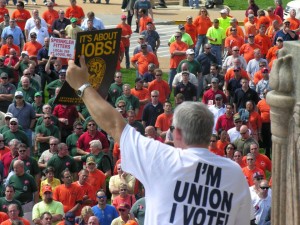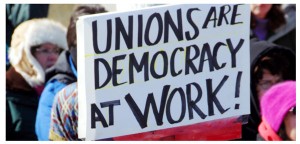Nation’s share of union workers remains unchanged
 Illinois up slightly; Missouri basically steady
Illinois up slightly; Missouri basically steady
Washington (PAI) – Union membership in the U.S. rose by 162,000 in 2013, to 14.528 million, the Bureau of Labor Statistics (BLS) calculated, but the union share of the nation’s workers stayed unchanged at 11.3 percent.
• Illinois: Union membership jumped to 851,000 (15.8 percent) in 2013, up from 801,000 (14.6 percent) in 2012.
• Missouri: Union membership was basically unchanged from 224,000 (8.9 percent) in 2012 to 219,000 (8.6 percent) last year.
Nationwide, African-Americans were more unionized than whites or Hispanics, and the oldest workers – aged 45-64 – were more unionized (14.5 percent) than other age groups, BLS reported. Almost eight million men were unionized, compared to 6.58 million women.

Union members’ share of the private sector workforce was 6.7 percent last year, a ratio unseen since the pre-labor law era of the Roaring 20s.
The private sector employed 7.31 million union members last year, 100,000 more than in the public sector. In 2012, the public sector had edged ahead.
WHY THE NUMBERS MATTER
The declining share of unionized private sector workers is important because when one private workplace is unionized – and its workers get better wages and benefits – its competitors often must match it.
And there’s a big wage gap: The median weekly wage for union workers last year was precisely $200 more than that for non-union workers, BLS said: $950 vs. $750. The median is the point where half the workforce is above it and half below it.

There’s still a wage gap between union men and union women, but it’s narrowing – and it’s a lot less than for non-union men and women.
The median wage for a male union member was $991 last year, compared to $898 for a female union member or 90.6 percent of the median male. Non-union men earned $831 weekly, while women earned $676 (81.3 percent).
WHERE THE MEMBERS ARE
Once again, union members were concentrated in the Northeast, the Midwest and the Pacific Coast. New York (24.4 percent), Alaska (23.1 percent), and Hawaii (22.1 percent) led in union density.
California again led in absolute numbers with 2.43 million union members, 16.4 percent of its workers. Next were New York, (1.99 million, 24.4 percent), Illinois (851,000; 15.8 percent), Pennsylvania (701,000, 12.7 percent), Michigan (633,000, 16.3 percent), New Jersey (611,000, 16 percent) and Ohio (605,000, 12.6 percent).
In those big states, New York and Illinois jumped both union numbers and density. New York added 145,000 unionists and Illinois added 50,000. Density rose by 1.2 percentage points in both states.
California and Pennsylvania lost both numbers and density, New Jersey stayed the same, and Michigan and Ohio gained slightly.
Despite Right Wing GOP Gov. Scott Walker’s law trashing public unions, Wisconsin union numbers (+24,000, to 317,000) and density (+0.3 percent, to 12.3 percent) both rose last year.
There was no public-private breakdown by state.
The anti-union South had the lowest union density, except that Right Wing-dominated Utah replaced Texas on the list of least-unionized states. North Carolina (3 percent) was last, trailed by Arkansas, Mississippi, South Carolina and Utah, in that order.
IMPROVEMENTS AND EROSION
 AFL-CIO President Richard Trumka had no immediate comment on the numbers, but Larry Mishel, director of the Economic Policy Institute, did.
AFL-CIO President Richard Trumka had no immediate comment on the numbers, but Larry Mishel, director of the Economic Policy Institute, did.
Mishel noted that private-sector union membership rose in construction and manufacturing, two of the more-unionized sectors of the workforce, accounting for the entire increase in union numbers.
But the share of public sector workers whom contracts cover dropped, he pointed out. That includes the 1.5 million “free riders” who get benefits of contracts but who don’t pay union dues, just fair share fees.
A current U.S. Supreme Court case, Harris vs. Quinn, challenges even those fair share fees from the free riders as a violation of the free riders’ free speech rights.
“More than 35 percent of net new jobs” in factories and construction “were covered by collective bargaining agreements,” Mishel said. “Improvements in the private sector have been offset, however, by erosion in the public sector.”
Between 2012 and 2013 union coverage in the public sector fell from 39.6 percent to 38.7 percent.
The starkest change was in Wisconsin, where union coverage in the public sector fell from 53.4 percent in 2011 to just 37.6 percent in 2013.
“This suggests that the erosion of public sector union coverage reflects the new anti-collective bargaining policies implemented in several states,” Mishel added.
Wisconsin’s Walker jammed his law, written by the secretive American Legislative Exchange Council (ALEC) corporate lobby, through the GOP-run state legislature in 2011. He overcame massive protests and strong labor lobbying.

